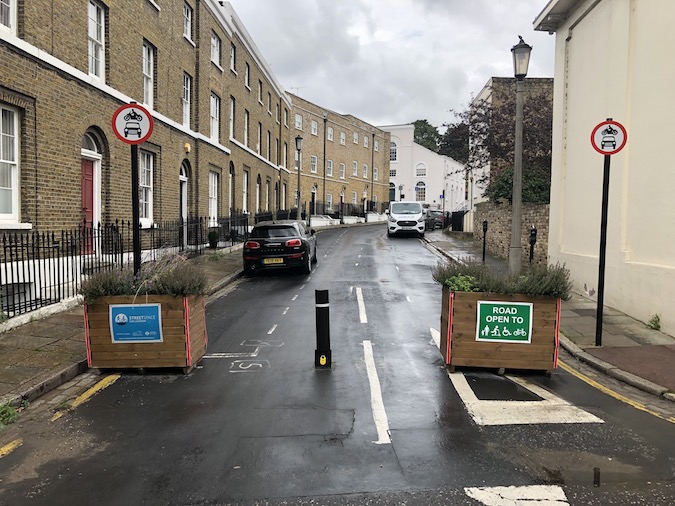Low Traffic Neighbourhoods (LTNs) have been among the most politically sensitive issues for councils in London in the last few years and it is tempting to see the recent borough elections as a referendum on them.
Local elections are always about a mix of topics – from neighbourhood level issues – for example an LTN or a planning application – to council-wide ones, such as the level of council tax, right up to national concerns and the state of the political parties in Westminster.
Polling Centre for London conducted in partnership with Savanta in advance of the elections confirmed this. It found that the level of council tax, social care and national issues were top concerns in deciding how people would vote.
Schemes to facilitate walking and cycling ranked much lower – only 12 per cent picked this in their top three. But, given the small numbers of people voting in them, some wards are won on razor thin majorities of just a handful of votes. Therefore local campaigns, whether in favour of or against an LTN, certainly had the potential to make a difference.
Taking last week’s results into consideration, it is clear no borough changed political control solely as a result of the introduction of LTNs. It is certainly the case that in some of those councils which introduced LTNs majorities were reduced, such as Enfield, or where the Conservatives won control from Labour, as with Croydon and Harrow. But it seems likely that other factors were more influential in these two boroughs, not least Croydon effectively declaring bankruptcy and the voting patterns of the Hindu community in Harrow.
To back this up, there are councils, including some in outer London, which introduced LTNs and either broadly maintained the same number of councillors or actually increased them (Labour in Hounslow, Waltham Forest and Ealing). In addition, in inner London, Labour councils that have introduced LTNs have been returned with very large majorities (Camden, Hackney, Lambeth, Lewisham, Islington, Southwark and Newham).
Conversely, Wandsworth, which suspended all its LTNs, and Westminster and Barnet, which didn’t introduce any during the pandemic, were lost by the Conservatives to Labour, but it doesn’t seem likely that LTNs were decisive in any of them. Tower Hamlets has its own local politics and Lutfur Rahman’s Aspire party, which won both the mayoralty and a council majority, took an anti-LTN stance. Whether that or other local factors won it for Aspire is unclear, but the fact that the party won councillors all over the borough, not just in those areas with LTNs suggests the latter.
Looking broadly at the results, there are probably a few lessons to learn from the election about LTNs:
- Councils are often faced with pressures on both sides. Some think their council went too far on LTNs, while some think it didn’t go far enough. Suspending controversial walking and cycling schemes can be seen as the easier option, but it often isn’t the case: councils that do this are likely to meet sustained local pressure for schemes to return.
- Many candidates in favour of LTNs generally stressed that any future walking and cycling schemes will be introduced after significant local consultation, neutralising one of the major criticisms of the opposing campaign groups. Usually this wouldn’t need saying, as consultation is a requirement for such schemes, but it does show that the introduction of LTNs through experimental traffic regulation orders – which means that consultation is conducted afterwards – has been bruising for councils. The context of the pandemic, when public transport use was discouraged, has been somewhat forgotten as the main reason for moving quickly.
- The issues that LTNs are there to answer are not going away. Councils still need to develop solutions to the climate emergency, air pollution, congestion, road deaths and injuries, noise, and the obesity crisis. The city has very tough net zero and modal shift targets, with a large gap in how these are actually going to be achieved. Councillors will be emboldened to know that a majority of Londoners want their street to look different: recent polling by Centre for London and Savanta shows that 58 per cent of Londoners want their street to become greener and 51 per cent want more space for walking.
- Advocates of walking and cycling schemes rarely branded them as Low Traffic Neighbourhoods. It’s likely we’ll see these schemes evolve, reincarnate under a different name and include a wider range of interventions – from school streets and bus gates to microparks – which will make LTNs more effective and improve the look and feel of local streets.
- Councils with LTNs that fought the election publicly supporting them will feel justified and emboldened to go further, faster. Councils that have been more reticent might look to those boroughs with LTNs, see the minimal voter kickback and be encouraged to bring them to their areas too. This is especially true of boroughs like Wandsworth and Westminster, which have low car ownership rates compared to the London average. What happens in these two councils following campaigns by Labour which didn’t deviate a vast amount from the previous administrations positions on reallocating road space, will be fascinating to watch.
Nicolas Bosetti is head of data and insight at Centre for London, on whose website this article was originally published. Follow Nicolas on Twitter.
On London is a small but influential website which strives to provide more of the kind of journalism the capital city needs. Become a supporter for £5 a month or £50 a year and receive an action-packed weekly newsletter and free entry to online events. Details here.

